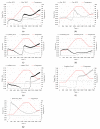Investigations on Functional and Thermo-Mechanical Properties of Gluten Free Cereal and Pseudocereal Flours
- PMID: 35804671
- PMCID: PMC9265335
- DOI: 10.3390/foods11131857
Investigations on Functional and Thermo-Mechanical Properties of Gluten Free Cereal and Pseudocereal Flours
Abstract
Seven commercial gluten-free (rice, oat, sorghum, foxtail millet, amaranth, quinoa, and buckwheat) flours were investigated in this study from the point of view of thermo-mechanical properties and solvent retention capacity (SRC). Each flour was used to prepare doughs with specific water absorption (WA) to get a consistency of 1.1 Nm (WA1) and doughs with WA2 levels higher than 85% to ensure a sufficient amount of water in the system for allowing the hydration of all components of the flours. Different correlations were established between proteins, ash, pentosans, damaged starch, and amylose contents on the one hand, and the capacity of the flour samples to retain different solvents such as sucrose, sodium carbonate and CaCl2 on the other hand. Although no significant correlation was found between the protein content of the flours and lactic acid-SRC, the mechanical weakening of the protein was significantly correlated with lactic acid-SRC for both tested WA levels. The doughs with WA1 had higher starch gelatinization and hot gel stability values compared to the corresponding dough systems with a higher water amount. Moreover, lower starch retrogradation and setback torques were obtained in the case of the dough prepared with higher amounts of water.
Keywords: Mixolab; dough consistency; gluten-free flours; solvent retention capacity.
Conflict of interest statement
The authors declare no conflict of interest.
Figures

References
-
- Cao X., Wen H., Li C., Gu Z. Differences in functional properties and biochemical characteristics of congenetic rice proteins. J. Cereal Sci. 2009;50:184–189. doi: 10.1016/j.jcs.2009.04.009. - DOI
-
- Badiu E., Aprodu I., Banu I. Trends in the development of gluten-free bakery products. Nnals Univ. Dunarea De Jos Galati Fasc. VI-Food Technol. 2014;38:21–36.
-
- Zhang K., Li X., Ma Z., Hu Z. Solvent retention capacity of oat flour: Relationship with oat β-glucan content and molecular weight. Food Hydrocoll. 2019;93:19–23. doi: 10.1016/j.foodhyd.2019.02.001. - DOI
-
- Yue J., Gu Z., Zhu Z., Yi J., Ohm J.B., Chen B., Rao J. Impact of defatting treatment and oat varieties on structural, functional properties, and aromatic profile of oat protein. Food Hydrocoll. 2021;112:106368. doi: 10.1016/j.foodhyd.2020.106368. - DOI
LinkOut - more resources
Full Text Sources
Research Materials
Miscellaneous

